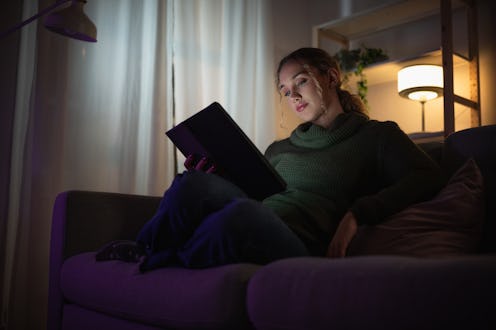Wellness
Sleep Restriction Might Actually Be The Trick To Curing Insomnia
It’s an expert-approved way to catch Zs.

You’ve probably heard about the benefits of sticking to a sleep schedule. This could be why your bedtime has always been 10 p.m. It seems early enough, but not too early, and it gives you plenty of time to get a full eight hours of rest before you need to wake up.
Like clockwork, you get ready for bed at 9:30 every night, even if you aren’t particularly tired, then you slip between the sheets and hope to nod off by 10:15 at the latest. But what if you don’t? According to sleep expert, one of the best things you can do is toss off your covers and stay awake.
This method is called “sleep restriction,” which refers to the idea that you should only go to bed when you’re actually tired. It also includes physically getting up out of bed if you find yourself lying there for a long time without falling asleep. In a viral TikTok, creator @mia.mentalhealth listed it as one of the many ways to help insomnia.
In her comments, one person said, “I would go to the couch when I was a kid when I couldn’t sleep, and it always worked. Makes sense now.” Sometimes that change of scenery is just what you need in order to feel tired. Here, a sleep expert explains why sleep restriction works.
What Is Sleep Restriction?
According to Karsyn Kapp, LPC, a licensed therapist and sleep expert at BodyMind Alliance Counseling & Consulting, sleep restriction is the gold standard treatment for insomnia. While it might sound like it’s about cutting back on sleep, it’s actually about restricting the time you spend awake in bed. “Sleep restriction is actually more like ‘tossing and turning restriction,’” she tells Bustle.
Instead of lying there feeling anxious and agitated — something that can train your brain to associate bedtime with stress — you’re supposed to get up and do something else. Better yet, you can skip the tossing entirely by going to bed only when you’re truly tired. That’s what sleep restriction is all about.
For a visual representation of the process at work, imagine a pizza dough. “Let’s say you have six inches worth of pizza dough — or six hours of total sleep time your body lets you get on average,” Kapp says. “If you’re trying to spread that over a 10-inch pan — or 10 hours of time in bed — what will happen? Most people recognize that there will be holes in the dough and really thin spots in the pizza crust.”
It’s a great metaphor for poor sleep, which can also feel stretched out and not quite right. “As many people who struggle with sleep know, more time in bed does not always equal more time asleep,” she says. “Sleep restriction is a short-term intervention to reset [your rest so you can have] much more consistent, good sleep in the long run — rather than once in a while.”
How To Try Sleep Restriction
To try sleep restriction, track your sleep for a week, looking at the average total time you spend snoozing each night. Then, set a bedtime that grants you that amount of sleep time plus 30 minutes. If you usually sleep six hours, that means you should go to bed at 11:30 p.m. for a 6 a.m. wake-up call. According to Kapp, the extra half hour accounts for how long it takes to drift off, as well as any brief wake-ups in the middle of the night.
If you don’t drift off within 15 minutes, or if you can tell that your brain is simply too switched-on to snooze, Kapp recommends getting up and doing something else, like reading, making tea, working on your novel, or listening to relaxing music. Try to stay away from your phone, loud noises, and heart-pounding shows. When you feel tiredness creep back in, go to bed.
The other trick is to steer clear of your bedroom until your eyelids start to get heavy or you catch yourself nodding off on the couch. “If you’re wired up, stressed, and not sleepy, don’t get into bed,” she says. “Even if it is past the scheduled time. Why? Because we’re training the body to associate the bed with deep quality sleep.”
According to Kapp, sleep restriction isn’t something that’s meant to be done long-term, but you should give it a couple of weeks. “Many people try it for a night and think ‘this didn’t work,’ but it takes time to build the association between bed and sleep,” she says. You need to give your body and mind enough time to adjust. If you’re truly struggling to sleep over a long period of time, she recommends going to a sleep specialist.
The Takeaway
If you can’t seem to fall asleep at night, consider staying up past your bedtime. The goal with sleep restriction is to ensure you’re truly tired once you lie down. As you adjust your bedtime and focus on getting quality sleep first, you can eventually aim for quantity by adding more hours to your routine.
While this is a great hack for those with true sleep issues, the idea of staying up until you’re actually tired can work for anyone. According to Kapp, sleep restriction is about making your body “hungrier” for sleep. If you only go to bed when you’re truly tired, you’ll not only fall asleep faster, but you’ll also likely sleep much more deeply.
Source:
Karsyn Kapp, LPC, licensed therapist, sleep expert at BodyMind Alliance Counseling & Consulting